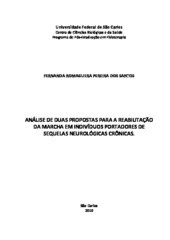Análise de duas propostas para a reabilitação da marcha em indivíduos portadores de sequelas neurológicas crônicas

Visualizar/
Data
2010-05-10Autor
Santos, Fernanda Romaguera Pereira dos
Metadata
Mostrar registro completoResumo
This work is composed of three distinct studies. In the first one, we compared the muscle coactivation of tibialis anterior (TA) and gastrocunemius medialis (GM) during quiet stance and the also during the stance phase of gait in hemiparetic subjects (hemiparetic group, HG, n=12) and in subjects with no neurologic injuries (control group, CG, n=10). We evaluated the TA and GM electromyographic signal and calculated their overlapping ratio (OR). We concluded that these individuals do not present significant coactivation alterations in the stance phase of gait, but in quiet stance they seem to use the coactivation of the non-paretic limb to maintain postural stability. In the second study we investigated the effects of the association of treadmill training with body weight support (TTBWS) associated with strength training of ankle muscles on the motor control in chronic hemiparetic subjects. Fifteen volunteers were distributed into 2 treatment groups: 1) TTBWS (G1; n=7); and 2) TTBWS associated with resistance training for dorsi and plantar flexors (G2; n=8). We evaluated muscle performance of plantar flexion and dorsiflexion in an isokinetic dynamometer through peak torque (PT), total work (TW) and acceleration time (AT) at the speeds of 60°/s and 120°/s. For gait analysis we assessed the ground reaction forces (GRF). There was an increase in PT and TT of plantar flexion at 60°/s in the paretic side, and an increase in the positive peak of the anterior-posterior GRF component in both sides of G2. We suggested that the proposed intervention leads to improvements in the components related to propulsion of gait. In the third study, we evaluated the effect of the robot assisted gait training (RAGT) in children with spastic diplegia. Twenty children (12 male, 5-13 years old) were evaluated for functional outcomes and spatial-temporal patterns of gait before, after and 3 months after the end of the intervention. Comparisons revealed significant improvements on functional outcomes and in gait mechanics. We concluded that RAGT promotes better gait patterns, and that the learning of this new task is retained even after the end of the intervention.